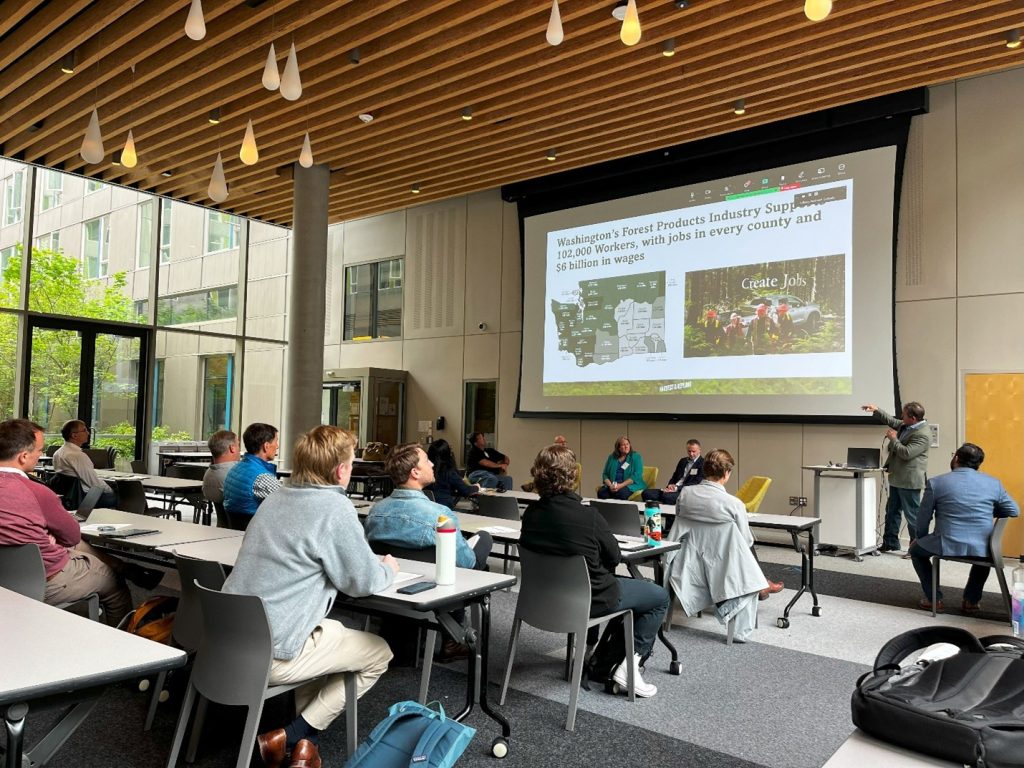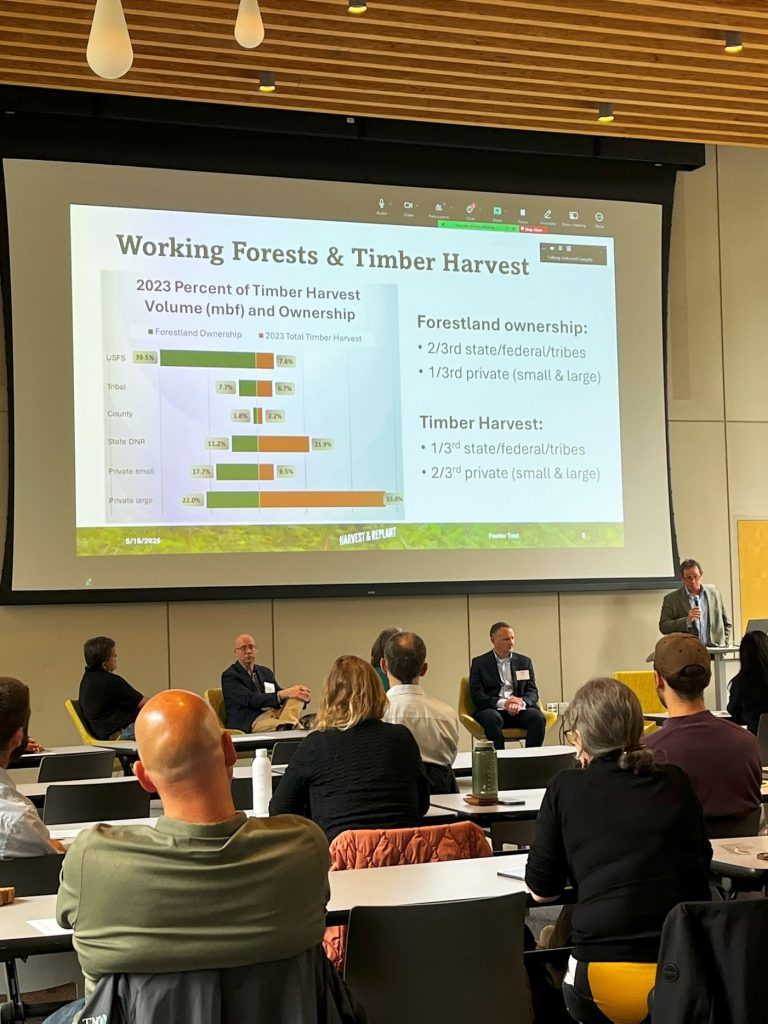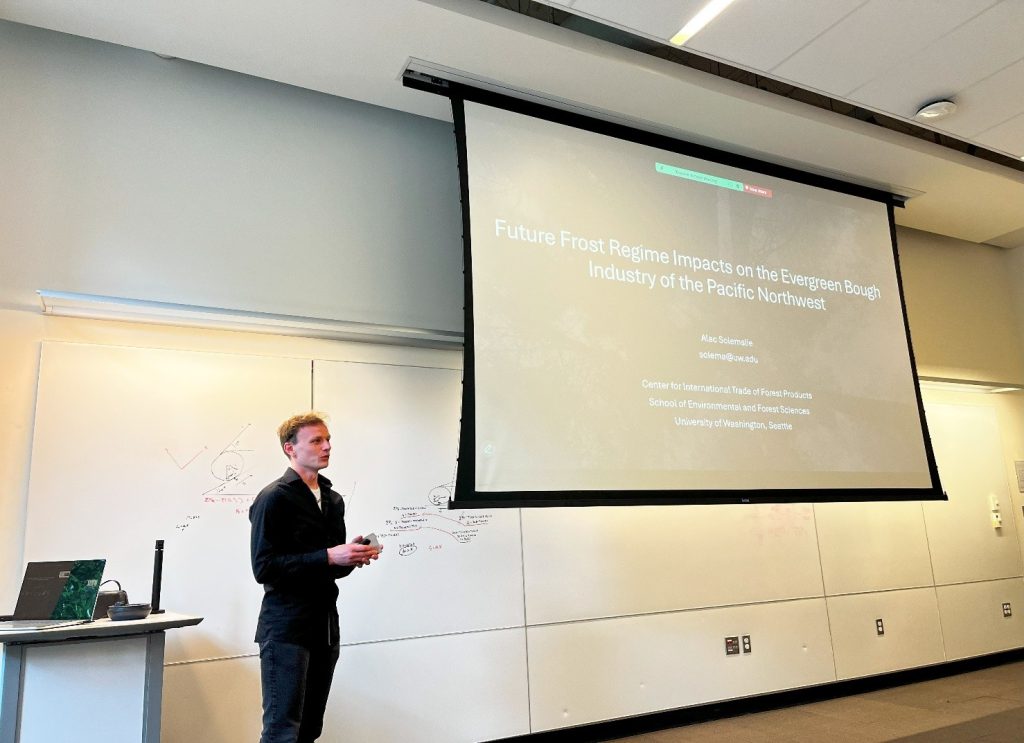Conference
CINTRAFOR leads critical conversations in forest management practices in the PNW and around the world at an international conference

How long should trees be grown before they are harvested?
The choice of rotation length is a crucial consideration for forest managers. Long rotations, focused on extending the time before logging, are being proposed because of perceived ecological and potentially economic benefits. Along similar lines, the ecological benefits of set-aside forests are also being discussed in public policy arenas and environmental communities. But some of these hypothesized advantages are contested.
Understanding the implications of long rotations is more critical than ever for policymakers, businesses, and landowners. Proponents of extending rotations argue that longer rotations can reduce greenhouse gas emissions by sequestering carbon for extended periods and by producing high-quality timber. The counterarguments cite that the proclaimed benefits are offset by questions of economic viability, diminished timber supplies, wildfire hazards and other perils endangering the health of forests. The challenge for stakeholders is to find smart forestry solutions while contending with climate change.
Indroneil Ganguly, Associate Director of CINTRAFOR and President of the Western Forest Economists (WFE), in collaboration with Harry Nelson, Professor at the University of British Columbia, spearheaded an effort to understand this dynamic at a recently held conference. With support from CINTRAFOR, the University of Washington hosted the 2-day WFE Annual Meeting 2025 on its Seattle campus on May 15th and 16th, 2025. This year’s theme was “Long Rotations and Set-aside Forests: Economic and Environmental Implications.” The conference brought together academics, management level professionals from local federal and state agencies, private forest industries, NGO representatives, and international experts. Participants assessed real-world problems related to long rotations and competing interests, issues of costs and benefits, public perceptions versus good forestry, and the need to collaborate across differences.
“Since its inception in 1966, the WFE Annual Meeting has spurred a robust exchange of ideas in economics research in forestry, and we are excited to take the lead in expanding research, learn from professionals with deep experiences, and drive new directions in forest management practices,”
“Since its inception in 1966, the WFE Annual Meeting has spurred a robust exchange of ideas in economics research in forestry, and we are excited to take the lead in expanding research, learn from professionals with deep experiences, and drive new directions in forest management practices,” said Ganguly who was the primary organizer of the event.
A plenary session moderated by Ganguly brought together speakers Gareth Waugh, Vice President, Port Blakely, Jason Spadaro, Executive Director, Washington Forest Protection Association, Elaine Oneil, Executive Director, Washington Farm Forestry Association, Duane Emmons, Assistant Deputy Supervisor for State Uplands, WA DNR, and Matt Comisky, WA Manager, American Forest Resources Council. They spoke about local circumstances: how forest management practices in Washington are affected by the size of landownership as well as by current laws in timber harvest, advocacy and communication campaigns, and industry dynamics. Through this discussion, the speakers addressed key lessons about the strengths and limitations of long rotations in Washington.
The discussion pointed to a crucial takeaway: the goal of sustainable forestry should be to actively manage forests, not do nothing. Forests will do better if people balance conservation efforts with economic needs. Based on the discussion, harvesting and replanting will keep forests healthy, maximize revenue earnings for landowners, and maintain timber supplies for the forest products industry while meeting ecological objectives.

Another plenary session held on the second day of the conference, moderated by Harry Nelson drew attention to complicated ground realities that evade modeling, making predictions of outcomes unreliable. Hugh Scorah, a researcher at the University of British Columbia, spoke of uncertainties embedded in theoretical approaches. In a similar vein, Ganguly emphasized reality checks to assess risk factors in long rotations. Dr. Raju Pokharel, Assistant Professor, Michigan State University, drew from extensive data in forest management practices in Maryland and Pennsylvania to infer that extended rotations negatively impact the economics of forest management. The speakers debated the topic passionately and showcased how to disagree insightfully.
In a special session titled “Collaborative Efforts in Resolving Forestry Issues,” Rajat Panwar, Professor, Oregon State University, and Tim Hawkins, Research Director at Westcoast Aquatic Society, wrestled with ways to bridge the disconnect between academic approaches and practical ground-level questions. The speakers debated how to create a culture of collaborations among corporations, NGOs, landowners, academics and other stakeholders— most fundamentally, by creating common narratives about shared realities. The discussion emphasized that people, companies, and organizations who work on trust-building will be better positioned to solve problems in forestry. The question of efficient collaboration was revisited in a luncheon session on the second day by Chris Page, Senior Facilitator for Projects & Strategic Initiatives at William D. Ruckelshaus Center, and Julie Anderson, the forestry sector lead of WA Commerce.
Besides the plenary sessions, there were also individual presentations by graduate students, postdoctoral scientists and researchers. Questions and answer sessions allowed audience members to constructively engage the topics. Cash prizes were given to two graduate students and one post-doctoral scholar for impressive presentations. CINTRAFOR research scientist, Dr. Abdallah Akintola, and graduate student, Alec Solemslie, each won an award. The abstracts of all presentations will be published in the Journal of Forest Business Research.
The discussions underscored the pressing issue of conflict management in forestry to repair relationships in a climate of distrust and division. The speakers emphasized that while global narratives can be instructive, they are not always relevant at local levels, and that it is possible to build a culture of trust through practice.
“The WFE Annual Meeting 2025 sets a model of industry-academia-NGO conversations,” said Ganguly. “The conference stands out with an emphasis on collaborations, providing forestry stakeholders with invaluable insights and experience into diverse perspectives in the critical issue of long rotations.”
The successful conference is a cornerstone of CINTRAFOR’s impact, building strong relationships with forestry stakeholders in the Pacific Northwest and around the world.

